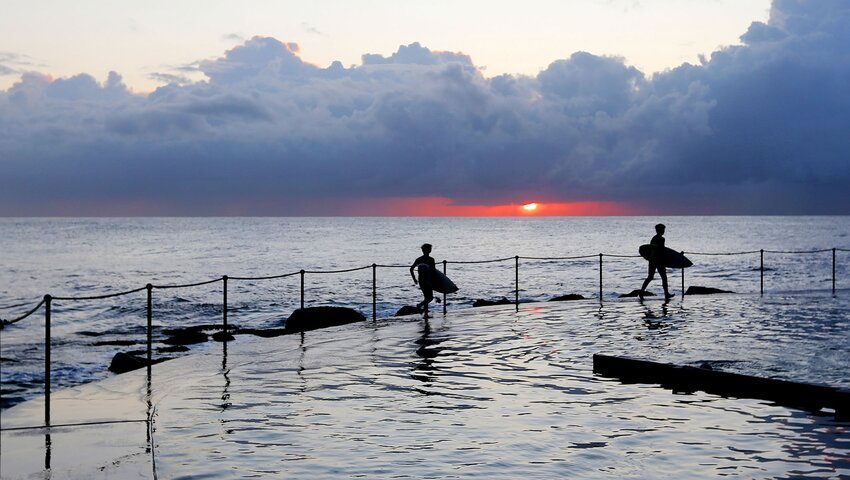Australia, situated between the Pacific and Indian Oceans, is both the world’s largest island and its smallest continent. The Land Down Under offers vast spaces to explore, enticing travelers with diverse sights and experiences. Whether immersing oneself in the rich traditions of the Aboriginal people, basking on sun-kissed beaches, or enjoying the vibrant city life, Australia has something special for every visitor.
The country boasts numerous national parks and islands, allowing travelers to seamlessly transition from exploring Tasmania to experiencing the wonders of Kakadu and Uluru-Kata Tjuta National Parks.

Australia’s pristine beaches and turquoise waters are home to the breathtaking Great Barrier Reef, a natural marvel and a top tourist destination. With an abundance of attractions and activities, planning an itinerary becomes a delightful challenge.
Canberra, Australia’s capital, established in 1913 as a planned city, is evolving into a lively and charming destination. Nestled amidst nature reserves and mountains, Canberra now features world-class museums, art galleries, and national monuments. The city’s growing vibrancy is complemented by a thriving nightlife, diverse shopping options, and a rich historical tapestry.

The Pinnacles, located within Western Australia’s Nambung National Park, unveil spectacular limestone formations reminiscent of weathered tombstones. Protected since 1967, these unique structures rise dramatically from the desert floor, offering an otherworldly landscape where debates about their origin continue. The Pinnacles have become a popular tourist attraction, often hosting Western grey kangaroos, emus, dingoes, and honey possums.
Also check: Exploring 14 Renowned Urban Plazas Worldwide
Gold Coast, blessed with year-round warm weather and sunny skies, lies south of Brisbane on Queensland’s southeastern coastline. Surfers Paradise, the heart of the Gold Coast, beckons with its vibrant atmosphere, featuring shopping malls, nightclubs, restaurants, bars, and expansive beaches ideal for sunbathing and watersports. Beyond its touristy reputation, the Gold Coast boasts stunning natural attractions, amusement parks, and nature reserves.

Alice Springs, positioned in the Northern Territory’s outback, is a remote town surrounded by captivating desert landscapes, rock formations, and gorges. While the town offers insights into Aboriginal history and culture through museums and art galleries, its main allure lies in the awe-inspiring landscapes. Iconic sites like Uluru and Kata Tjuta, with their distinctive features and vibrant colors, draw visitors seeking a unique outback experience.
Karijini National Park, Western Australia’s second-largest national park, showcases the beauty of the Hamersley Ranges. Its mountainous terrain features stunning gorges, slot canyons, and waterfalls, with the three highest peaks in Western Australia offering fantastic hiking opportunities. The park’s semi-arid landscapes are punctuated by hidden water holes and waterfalls, providing a refreshing contrast to the rugged scenery. Rich in biodiversity, Karijini is home to diverse plant species and fascinating wildlife.
Darwin, hugging Australia’s Top End coastline in the Northern Territory, has a resilient spirit forged through challenges like World War II and Cyclone Tracy. Today, the city thrives as a popular holiday destination, offering a sandy beach lined with open-air bars and seafood restaurants. Darwin serves as a hub for exploring Kakadu National Park, Litchfield National Park, and Katherine Gorge, while also featuring cultural attractions like the Deckchair Cinema and diverse aquatic adventures.
Daintree Rainforest, on Australia’s northeast coast in Queensland, stands as one of the world’s oldest and most diverse tropical rainforests. Beyond lush rainforest, the region includes rugged mountains, teeming rivers, coral reef systems, and pristine beaches, notably Cape Tribulation. Cairns, approximately a three-hour drive away, serves as a gateway to Daintree, offering nature lovers a range of outdoor activities such as hiking, wildlife watching, paddleboarding, ziplining, and river cruises.
Byron Bay, located in New South Wales at the easternmost point of Australia’s mainland, is celebrated for its idyllic beaches, excellent surf spots, and laid-back lifestyle. Beyond hosting arts and culture festivals, the town offers diverse outdoor activities, including scuba diving, surfing, whale-watching, skydiving, and yoga. Byron Bay’s alternative vibe and scenic beauty attract a mix of residents, from artists and surfers to families, resulting in a range of trendy bars, restaurants, galleries, and accommodation options.
Fraser Island, the world’s largest sand island, lies off Queensland’s southeast coast, separated from the mainland by the Great Sandy Strait. Stretching over a hundred kilometers, Fraser Island features white sandy beaches, sand cliffs, rainforests, mangroves, and numerous freshwater lakes. Great Sandy National Park preserves this stunning landscape, home to diverse wildlife such as dingoes, dolphins, wallabies, and whales. The island offers opportunities for hiking, swimming, watersports, and camping under the stars.
Broome, perched on a small peninsula on Western Australia’s northern coast, serves as a gateway to the region’s scenic wonders. Cable Beach, renowned for its white sands and turquoise waters, invites visitors to relax, enjoy luxury resorts, and experience sunset camel rides. Broome’s attractions include rock formations at Entrance Point, red cliffs and dinosaur footprints at Gantheaume Point, and the breathtaking Horizontal Falls in the Dampier Peninsula and Kimberley Region.
Cairns, situated on the northwest corner of Australia, stands out for its tropical climate, laid-back ambiance, and proximity to the Great Barrier Reef. Bordering mountains and the Coral Sea, Cairns offers a saltwater lagoon, trendy cafés along the Cairns Esplanade, and numerous nearby beaches. Adventure enthusiasts can engage in snorkeling, scuba diving, skydiving, and whitewater rafting. The Daintree Rainforest, considered the world’s oldest tropical rainforest, provides unique hiking experiences and an aerial walkway through lush forests.
Kings Canyon, located in Watarrka National Park in the Northern Territory, captivates visitors with its colossal size, stunning scenery, and unique geological formations. Formed over 400 million years ago, the gaping gorge features towering walls, cliffs, and a small creek below. Kings Canyon holds cultural significance for the Luritja people and remains a sacred site. Hiking opportunities abound, offering spectacular views and a chance to explore the canyon’s shaded areas.
Also Read: Exploring the 7 Most Isolated Monasteries Around the Globe
Adelaide, the capital of South Australia, sits on the eastern shores of Gulf St Vincent. Known as the “city of churches,” Adelaide combines lofty spires, parks, and green spaces with a multicultural gourmet food and café culture. Surrounded by famous wine regions, the city offers proximity to the Barossa Valley, Clare Valley, McLaren Vale, and Adelaide Hills. Adelaide’s festivals, including the Adelaide Festival and Adelaide Fringe Festival, celebrate arts, music, and the city’s rich social history.
Blue Mountains, located just west of Sydney in New South Wales, offers accessible and awe-inspiring natural wonders. Sprawling over a vast area, the Blue Mountains feature majestic mountains, plateaus, and escarpments shrouded in mist from the eucalyptus trees. Well-maintained hiking trails and mountain bike paths provide breathtaking views from Echo Point and Govett’s Leap. The region is also rich in Aboriginal history and culture, with charming towns and villages showcasing art galleries, craft shops, and sophisticated restaurants.

































